
More from Brian Selznick
“I love being an illustrator because I get to read really great stories, work with amazing people, travel, and see places I never would've seen.” —Brian Selznick
If you liked the looks of The Invention of Hugo Cabret, then chances are you’ll also want to feast your eyes on these other books illustrated by Brian Selznick. Check them out!
And for a complete list of all of Brian Selznick's books, visit his
web site.
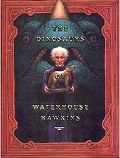 The
Dinosaurs of Waterhouse Hawkins: An Illuminating History of Mr. Waterhouse
Hawkins, Artist and Lecturer by Barbara Kerley (illustrated
by Brian Selznick)
The
Dinosaurs of Waterhouse Hawkins: An Illuminating History of Mr. Waterhouse
Hawkins, Artist and Lecturer by Barbara Kerley (illustrated
by Brian Selznick)
Almost nobody knew what a dinosaur was until the mid-1800s, when Victorian artist Waterhouse Hawkins built the first life-size models of dinosaurs. This is the unforgettable story of Waterhouse Hawkins, his triumphant spirit, and his dinosaurs.
Brian says . . . “I always liked dinosaurs; I remember when I was a kid, one of the first things I had ever made was a tin-foil sculpture of dinosaurs. While I was working on this book, sometimes I felt like Waterhouse Hawkins. Not only did I get to go and see the actual dinosaurs he made and get to touch them, but when I was doing the drawings, I needed to imagine what he was thinking and feeling. I tried to take those feelings and put them in the painting.
"Barbara Kerley told me there was a scrapbook in Philadelphia that used to belong to Waterhouse Hawkins. So I went to see the scrapbook in Philadelphia. The scrapbook was filled with pictures of Waterhouse's studio and photographs of him and drawings he had done of the dinosaurs. It was really incredible to flip through these pages and touch these pages that Waterhouse had touched.
"One of my favorite images in the book is the picture of the scientists
having dinner inside the iguanodon, because I would have loved to have
been there that night. It was really fun to imagine what that dinner
would have been like with the candles glowing, the waiters serving all
of that food, and the scientists making up songs about dinosaurs.”
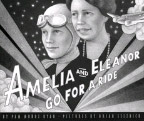 Amelia
and Eleanor Go for a Ride by Pam Muñoz Ryan (illustrated
by Brian Selznick)
Amelia
and Eleanor Go for a Ride by Pam Muñoz Ryan (illustrated
by Brian Selznick)
One evening in April 1933, Amelia Earhart and Eleanor Roosevelt stole away from a White House dinner, hopped in an airplane, and took off on a glorious adventure over Washington, D.C. — while still dressed in their evening gowns!
Brian says . . . “I like to go to art museums and science museums and learn about new things. To research Amelia and Eleanor Go for a Ride, I went to Washington, D.C., and lived there for six months. I lived about seven blocks from the Capitol. So I got to do a lot of research in the buildings where the story takes place. I went to the White House and saw the Red Room. I went to the Smithsonian Institution and saw one of Amelia Earhart's real airplanes. I saw some dresses that Eleanor Roosevelt used to wear. For the drawing where Amelia and Eleanor are driving down the street, I just walked outside and drew the street I was living on. So you'll see that on the left side of the drawing there's a big lit-up window — that's where I used to live.
"I was having trouble drawing the back of Eleanor Roosevelt's
head because all of the photographs I had of her were taken from the
front. So I made a little clay sculpture of Eleanor Roosevelt's head.
When I was finished, I baked it in the oven to make it hard. Then, I
was able to hold it up to the light and turn it around and see what
the back of Eleanor Roosevelt's head looked like.”
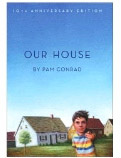 Our
House by Pam Conrad (illustrated by Brian Selznick)
Our
House by Pam Conrad (illustrated by Brian Selznick)
Almost overnight, a bunch of potato farms in upstate New York disappear, replaced by rows of identical little houses. The suburbs have arrived! Read six stories, one from a kid in each decade from the 1940s to the 1990s, and see how Levittown, and the country, changed through the years.
Brian says . . . “On December 21, 1994, we visited all
the spots Pam wrote about in the book. I brought two cameras with me
just in case one didn’t work, and I photographed the water tower,
where the famous night photograph was taken in the 1950s. In that picture,
the houses of Levittown all glow like rows of spaceships in the black
night. And of course, I photographed house after house. We were even
able to find some houses that hadn’t changed at all since the
1940s, but most of the houses had grown and transformed, just the way
Pam describes so beautifully in the book.”
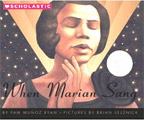 When Marian Sang: The True Recital of Marian Anderson
by Pam Muñoz Ryan (illustrated by Brian Selznick)
When Marian Sang: The True Recital of Marian Anderson
by Pam Muñoz Ryan (illustrated by Brian Selznick)
Marian Anderson was an extraordinary singer — the first African American to perform at the Metropolitan Opera. She is best known for her historic concert at the Lincoln Memorial in 1939. Marian’s life and career changed the way people saw African Americans forever. This book is an introduction to her life and legacy.
Brian says . . . “My uncle, Richard Selznick, was the family storyteller. While I was working on Amelia and Eleanor Go for a Ride, I brought some of my photographic research to his house because my little cousin was working on a report about Eleanor Roosevelt for school. When my uncle saw the picture of Eleanor Roosevelt presenting Marian Anderson with the Spingarn Medal, he told me he remembered being a college student in Washington, D.C., when they were there for Marian Anderson’s historic concert, and he helped bring them around town. ‘I knew both of those women,’ he said. Wow.
"I called Pam Muñoz Ryan to tell her this story, and a few days later she told me she wanted to write a book about Marian Anderson inspired by my uncle’s recollection. I was thrilled, and so was my uncle.
"I had originally intended to show Marian singing at the Lincoln
Memorial from her point of view; that is, from the stage looking out
into the crowd. But I saw a mural at the Department of the Interior
in Washington, D.C., that was painted to commemorate Marian’s
concert (‘An Incident in Contemporary American Life,’ 1942,
Mitchell Jamieson), and it showed the concert from the crowd’s
point of view. We are inside the sea of people, black and white together,
and in the distance we can just barely see Marian. I was very touched
by this mural and used it as the basis of the far left-hand section
of my painting.”
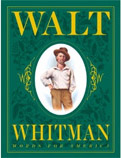 Walt
Whitman: Words for America by Barbara Kerley (illustrated
by Brian Selznick)
Walt
Whitman: Words for America by Barbara Kerley (illustrated
by Brian Selznick)
Did you know that poet Walt Whitman was also a Civil War nurse? Devastated by his divided country and compelled by his brother's war injury, Walt nursed all soldiers — Union and Confederate, black and white. By getting to know them, he began to see a greater purpose for his writing: he could give these men a voice, and in turn, capture the true spirit of America.
Brian says . . . “After I read an early draft of Barbara’s manuscript, my adventures began. On Long Island, I visited Walt’s birth home at West Hills in Huntington Station, as well as Old Bethpage Village Restoration, a reconstructed 19th-century town with an actual house where Walt might have stayed at one time. I saw the photos of Walt held by the Brooklyn Public Library, and I spent time in the Rare Book Room of the New York Public Library, where I held in my hand one of Walt’s original handmade notebooks. I turned the pages of this notebook and saw how he had tied the thread that held it together, and I read the entries that he had written lightly in pencil. It was thrilling.
"Most importantly, in my quest to try and understand him, I read Leaves of Grass. Reading Walt’s poetry is a very immediate experience. As Walt says in the poem ‘Crossing Brooklyn Ferry,’ ‘It avails not, time nor place — distance avails not, / I am with you, you men and women of a generation, or ever so many generations hence . . .’ That idea was very important for me while I worked on this book.”